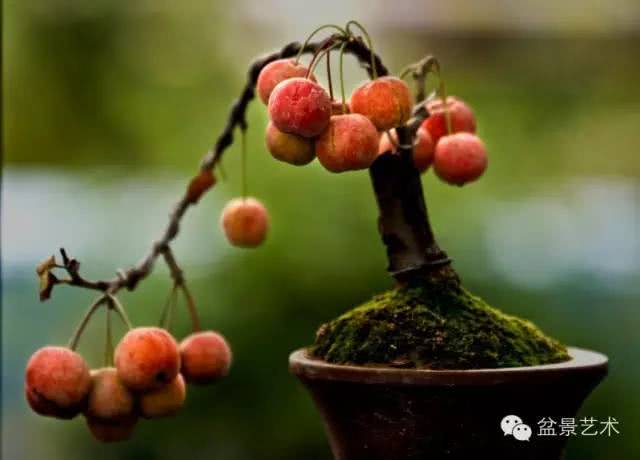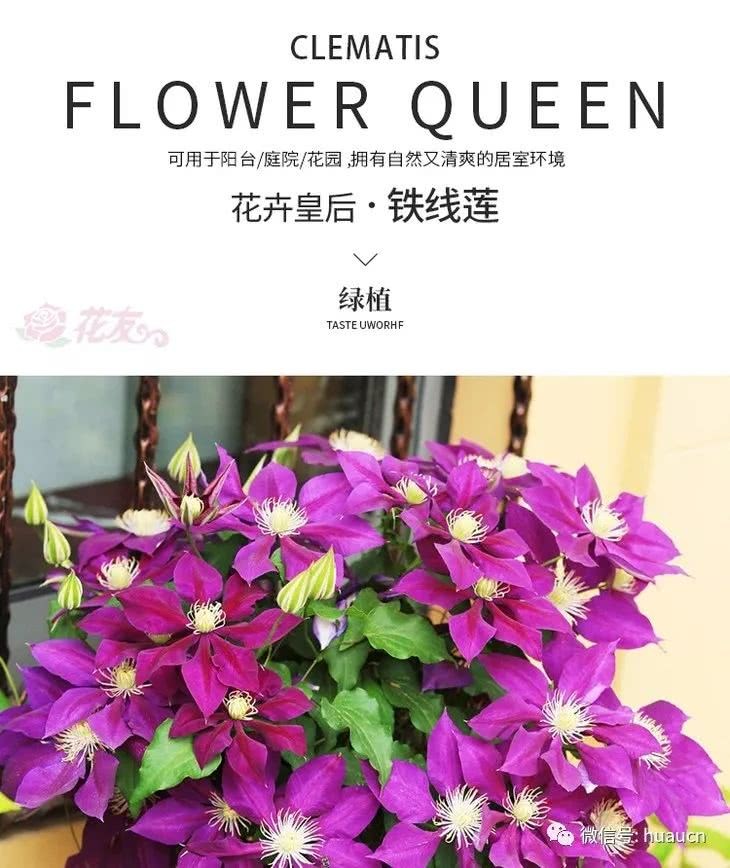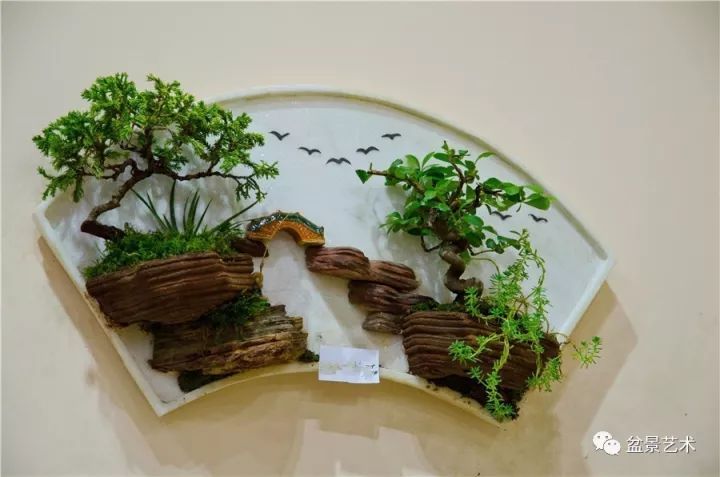Skill bonsai production and maintenance of small fruit trees

The bonsai of small fruit trees uses northern deciduous fruit trees such as apples, Hawthorns, persimmons, pomegranates, pears and peaches as the main materials, integrates modern fruit tree cultivation techniques with traditional bonsai modeling techniques, and reduces the fruit trees as high as several meters to tens of centimeters. Planted in a shallow basin that is not full-length and no more than a few inches high, it can blossom and bear fruit and grow normally, thus achieving the artistic effect of "seeing the whole through a small part" and "shrinking into inches". It has formed a "small fruit tree bonsai" in the real sense, and has become a wonderful work in the Chinese bonsai family.
Characteristics of bonsai of small fruit trees
Bonsai of small fruit trees should not only have plastic arts such as root, pile, shape and spirit, but also have a sufficient number of fruits. The number, layout, size and color of fruits are an important part of bonsai art of small fruit trees. only by closely combining the two, can the roots, stems, branches, leaves, flowers, fruits and types form an ornamental whole and make the spring flowers exquisite and graceful; autumn fruits are numerous and colorful; winter branches and bones are thinned and vigorous. And summer coincides with the period of fruit development and luxuriant foliage, and the green branches and fruits change their new appearance in ten days, which is full of interest in life and the flavor of nature.
Bonsai of small fruit trees should not only study the shape, but also pay attention to the cultivation of flowers and fruits, while the cultivation of flowers and fruits requires branches with certain growth potential, a certain number of leaves, as well as adequate nutrition supply. In addition, the flowers and fruits of some fruit trees, such as apples, pears, persimmons and Hawthorns, are just at the top of the branches. All these determine that the bonsai of small fruit trees can not prune the branches and leaves at will like the general bonsai, and its own law determines that a rough and natural style must be shaped in modeling and pruning. In terms of specifications, it can be miniaturized, but it is difficult to be miniaturized; in the treatment of branches and leaves, it can be layered, but it is difficult to become "slices"; in the overall shape, the basic shape can be arbitrary, but the details are difficult to be refined; and the number of bonsai results of small fruit trees varies from year to year, and the result location varies from year to year, so it is necessary to re-cultivate flowers and fruits every year, not once and for all. Therefore, the production and maintenance of small fruit tree bonsai requires certain skills, conservation knowledge and adequate nutritional conditions, which is its charm.
Production and maintenance skills
1. The soil used for pot cultivation is nutritious soil. In production, the raw materials of nutritious soil are often divided into the following three types: loam, such as pastoral topsoil, mountain soil, turf soil, etc., these raw materials can be adjusted to local conditions, but neutral sandy loam is the best; fertilizers, such as rotten leaf compost, barnyard manure, cake manure, etc., can be selected at will according to the actual situation, but we should pay attention to the difference in maturity and fertility. The third category is sand, slag (ash), vermiculite and other minerals, whose main function is to increase soil permeability. In production, pastoral soil, rotten leaf compost and sand are often mixed according to the proportion of 4:4:2.
The preparation of nutritious soil should also adjust the proportion and increase other raw materials according to different tree species, different pots and different conservation environment. The root system of peach has poor waterlogging tolerance, the basin soil needs to be loose and well ventilated, while the basin wall of glazed basin and purple sand basin is poor, so it is difficult to meet the needs of root respiration by using general nutrient soil. 10% to 20% coarse-grained sifted slag can be added to the general nutrient soil to increase its permeability.
When the bonsai of small fruit trees are maintained at home, it is easy to cause scorched leaves, wilting and shedding of fruits, and even branch withering and tree death due to small pots, short water retention time, untimely watering, dry ambient air and so on. Through years of experiments, the author comes to the conclusion that these problems can be solved by adjusting the ratio of nutritious soil and mixing 0.1 kg of water retention granules into each basin of soil. The water-retaining granule is non-toxic and harmless, does not pollute the environment, and its water-absorbing capacity is about 400 times of its own volume, and it is valid for three years at a time, so that the potted trees are watered once or twice a day in the family indoor environment. the water retention capacity was significantly improved, which fundamentally solved the difficult problem of bonsai maintenance of small fruit trees in the family, which has perplexed the healthy development of the industry for many years.
two。 Watering is the most common pot technique that is not easy to master. Watering in the pot should follow the principles of "dry and wet" and "watering thoroughly". Because the pores of the basin soil after watering are filled with water, a large amount of air is discharged out of the soil, which affects the root respiration, and the watering interval is too short, and the basin soil is prone to waterlogging under the condition of over-wet and anoxic for a long time. Therefore, it is necessary to wait for the basin soil to dry and whiten before watering, that is, "dry and wet". Beginners and families are afraid of water "big" waterlogging trees, each time the amount of water is insufficient, forming a "half-cut water". The lower half of the basin soil does not see water for a long time, that is, it becomes dry and hard, and the root system will naturally dry up and die. Therefore, it is necessary to check the basin tree after watering, and it is appropriate to wait for a small amount of water to seep out from the basin bottom hole, that is, "pour it thoroughly" to keep the humidity of the basin soil consistent, and its relative water content is generally between 50% and 90%.
3. The growth, flowering, fruiting and fruit development of small fruit trees need more nutrition supply, but the basin soil is small, the soil nutrient reserve is small, and it is easy to lose with water, which can not be satisfied only by the limited nutrients in the basin soil. Therefore, in order to maintain exuberant growth and normal flowering and fruiting of potted trees, it is necessary to apply a variety of nutrients in time during the growing season, but fertilizer damage caused by excessive fertilization should be avoided, so the principle of "frequent application of thin fertilizer" should be followed.
In the process of production and maintenance of small fruit trees bonsai, in order to achieve the purpose of reasonable fertilization, we must be suitable for trees, fertilizer, timely, appropriate amount, measures to local conditions, flexible grasp. Tree species with strong fertilizer tolerance and large growth and fruit, such as apples, pears and peaches, should be fertilized more, while less fertilizer-tolerant tree species, such as persimmon and pomegranate, should be fertilized less. The potted trees with less fruit and vigorous growth should apply less fertilizer, especially those with high nitrogen content, while the potted trees with more fruit and weak growth should apply more fertilizer. More fertilizer should be applied in the spring prosperous period and autumn nutrient accumulation period, less fertilizer should be applied in summer high temperature season to prevent vegetative growth, and no fertilization should be applied in dormant season. The physical and chemical properties of potted soil are good, and the newly potting trees with comprehensive and sufficient nutrient elements will not be fertilized temporarily, but the potted trees with poor fertilizer content or those who have not been potting and changing soil for a long time should apply more fertilizer. Topdressing should be carried out when the temperature is low in sunny days, so as not to cause fertilizer damage or nutrient loss.
Commonly used fertilizers are fermented peanut cake, sesame cake, soybean cake, rapeseed cake and so on. The method is to add a small amount of water and dry fertilizer to ferment fully in the container, and then dilute and irrigate. Use 100 times the concentration, that is, 1 kg of dry cake fertilizer soak 100 kg of water. In the alkaline soil area of North China or when the slightly acidic fruit trees are planted in the pot, ferrous sulfate equivalent to 1/10 of dry fertilizer can be added in the process of fermentation to make slightly acidic nutrient liquid fertilizer.
- Prev

Clematis rattan queen balcony garden courtyard planting perennial climbing vine horticulture abundant flower potted plant
END is an interactive platform for growing flowers, planting flowers, communicating with green plant lovers, farting and showing off. An online home to share flower farming methods and family flower cultivation skills. Flower subscription platform. Flowers: hyacinth | Violet | Plum Blossom | Carnation | Mountain.
- Next

Key points of hanging wall bonsai and its production
Hanging wall bonsai is a new type of bonsai art produced by bonsai workers who skillfully combine the traditional bonsai art with the production techniques and forms of handicrafts such as shell carving and bark painting, and absorb the essence of traditional Chinese painting and calligraphy. Hang the wallbasin.
Related
- Wuhan Hospital Iron Tree Blooming Result Was Instantly Frightened by the Gardener Master
- Which variety of camellia is the most fragrant and best? Which one do you like best?
- What is the small blue coat, the breeding methods and matters needing attention of the succulent plant
- Dormancy time and maintenance management of succulent plants during dormancy
- Minas succulent how to raise, Minas succulent plant pictures
- What are the varieties of winter succulent plants
- How to raise succulent plants in twelve rolls? let's take a look at some experience of breeding twelve rolls.
- Attention should be paid to water control for succulent plants during dormant period (winter and summer)
- Watering experience of twelve rolls of succulent plants
- Techniques for fertilizing succulent plants. An article will let you know how to fertilize succulent plants.

